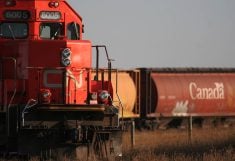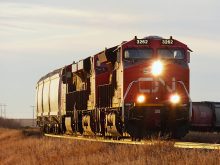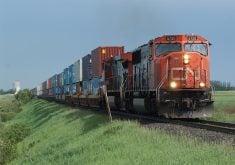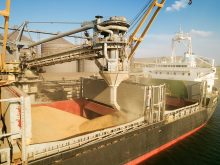Holding a knife to the throat of Canada has become a predictable national dysfunction.
The railroad companies and their unions just did that to farmers, with both Canadian National and Canadian Pacific Kansas City simultaneously slashing national jugular veins before the federal government stepped in to end the escalating labour dispute.
Related stories: WP rail labour dispute coverage
Read Also

Russian wheat exports start to pick up the pace
Russia has had a slow start for its 2025-26 wheat export program, but the pace is starting to pick up and that is a bearish factor for prices.
In 2020, Indigenous protests halted the rail system for weeks.
Environmentalists have stopped trains from time to time.
If farmers, or a subset of farmers, get very upset, they can easily block the rails to get attention.
It seems too tempting a target, for those hoping to force a positive result for themselves, to eschew rail stoppage.
It’s the economic form of the approach suggested by Quebec political scientist Leon Dion in 1990, when recommending how his province should deal with the rest of the country: “You must put a knife to the throat of English Canada. You must push them to the precipice.”
Farmers suffer most from rail stoppage vulnerability, since other commodities aren’t as sensitive to market windows. If crops can’t be moved in the autumn and early winter, before South American crops come off, the best prices will probably be lost for that crop year.
Canada is uniquely stretched, with almost all its population and arable land along a thin strip north of the U.S. border. The majority of its farmland is landlocked, cut off from the Pacific Ocean by the Rocky Mountains, exiled from the Atlantic by the Canadian Shield and Great Lakes, and from the Arctic by hundreds of kilometres of muskeg, wilderness and the brutality of winter.
The two mainline railways are thin strips that can be broken any time, as often happens with environmental conditions, including floods, forest fires and landslides. The human component is an exacerbating element.
Is there a better way to run this system that would avoid these costly and anxiety-producing shutdowns?
For labour disputes like the recent two-railway nightmare, the government was able to use its power to force resumption of service and binding arbitration.
Is that a good system? Or does it encourage railway management and labour unions to become intransigent, knowing they’ll almost inevitably be forced into arbitration?
In 2020, many farmers were outraged when rail lines were blocked for weeks by protests. Is there a better way to deal with that? Would quick arrests and track clearings by police improve the situation, or provoke an escalation and become an unacceptable infringement upon the rights of citizens to peaceful protest within a democracy?
Has any country in a similar situation found a better way to protect its railways from disruption?
I want to discover that.
Brazil’s Matto Grosso region is similar to Western Canada, being far from port and reliant upon long distance shipping of crops to the Atlantic coast or the Amazon River.
India has an enormous railway system, a gigantic agricultural economy and a relatively open economy. Some of its farming regions are far from port.
Australia isn’t similar because most of its ag lands are close to its coasts. The same is true for Argentina. Russia and China don’t count in this comparison because they aren’t democracies and their tracks can be kept clear by the raw exercise of state power.
But in Canada, we don’t do enough to learn from other countries’ experiences. Heck, sometimes we don’t even learn from neighbouring Canadian provinces.
If anything is true about farmers, it’s that they are frustrated by the grain transportation system. They feel, and we report upon, numerous failings of grain elevator companies, railroads, ports and exporters. All those failings end up stealing money from farmer’s wallets.
But most of us don’t know how well our system stacks up against others. It’s possible our system is actually pretty good. Don’t groan! I’m just saying it’s possible. At times Canadian railways have been judged the most efficient in North America. Stoppages are rare.
I hope to explore this within the next few weeks. Experts like Barry Prentice of the Transport Institute at the University of Manitoba might have some ideas. The federally appointed grain system monitor, Quorum Corporation, is packed with analytical muscle.
Transportation experts at Canadian commodity organizations might have looked at this. I hope to find out.
This double-whammy labour disruption terrified farmers and many Canadians due to this country’s severe vulnerability to rail shutdowns. How well we’re managing this vulnerability is hard to assess if we don’t know if anybody else does a better job.
Somebody will always be able to hold a knife to the nation’s throat. Farmers deserve to know if somebody has found a better way to protect their jugular.
















